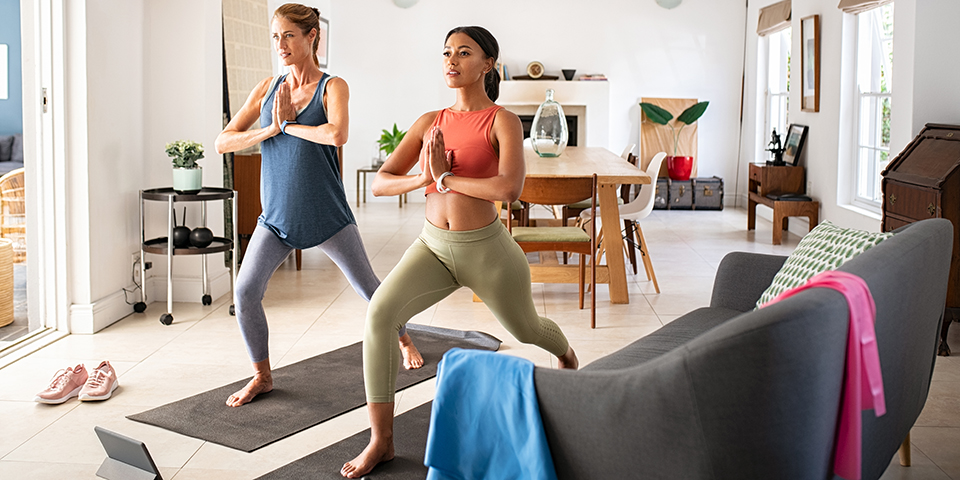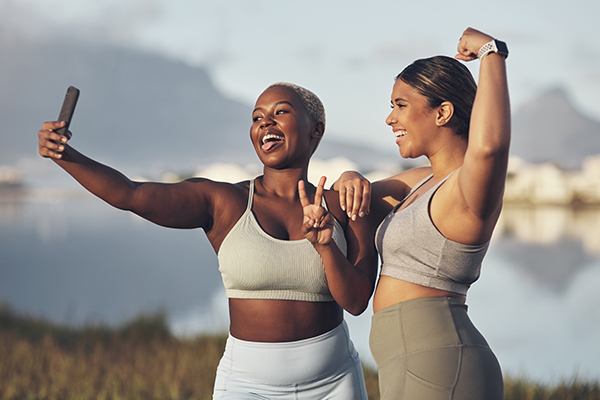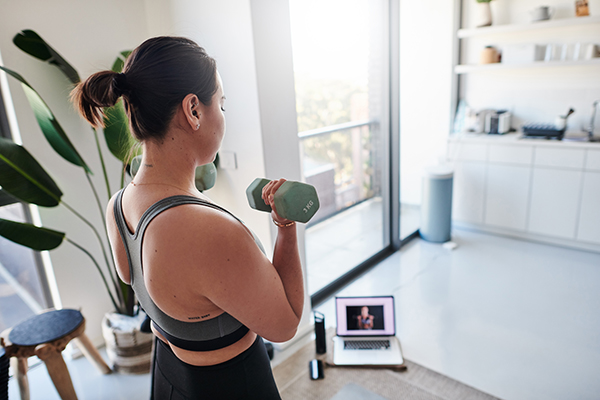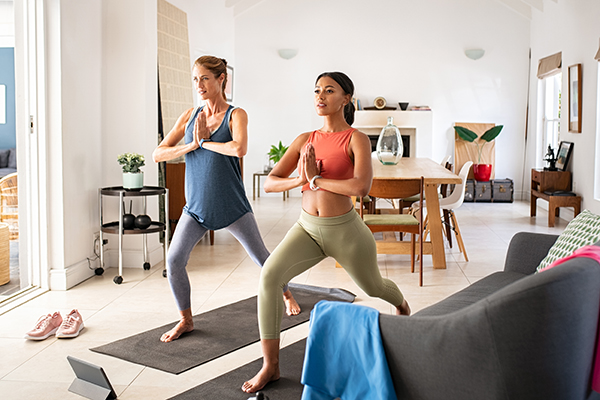Being motivated to get healthy for reasons other than to change one’s physical appearance isn’t uncommon these days – but that hasn’t always been the norm. For that, we can thank the body positivity movement.
“Body positivity is the idea that you feel good and love the body that you have, regardless of size, shape, color, etc.,” explains Dr. Rachel Goldman, Ph.D., FTOS, a licensed psychologist with a New York-based private practice. “It’s promoting the acceptance of all types of bodies.”
Even seeing diverse bodies on social media and in our daily life boosts our self-esteem, according to a 2023 study by Australian researchers.
Not only did this simple practice help the young women in the study break free from the comparison trap, but it was also called “an effective, inexpensive micro-intervention for improving” body image.
Read on to learn more about the history of the body positivity movement, how to integrate body-positive habits into your daily routine, and why many experts prefer body neutrality – or even body acceptance – instead.
What Is Body Positivity?
Body positivity can be as simple as embracing non-scale victories and focusing on the emotional benefits of working out.
It can mean eating food without assigning a moral value (e.g., “good” and “bad” foods).
It can look like posting pictures of yourself on social media without filters – which is how former supermodel Paulina Porizkova became a healthy aging activist.
“Body positivity is a movement to try to address our toxic culture that promotes thinness and vilifies fatness and contributes to mental health problems including eating disorders,” says Dr. Lauren Muhlheim, Psy.D., FAED, CEDS-S, a clinical psychologist and certified eating disorder specialist. “It tries to address unrealistic beauty standards and promote acceptance of all bodies.”
Shifting to a body-positive mindset takes time and work, but the benefits are worth it.
“Accepting one’s body improves one’s body image, self-esteem, and self-confidence, which all has a direct impact on one’s mental health and wellness,” says Goldman.
Is Body Positivity Just a Trend?
Body positivity isn’t a Gen Z invention, though it’s all over TikTok.
The movement started back in the 1960s, with roots “in Black fat activism to resist the rise of anti-fat discourse in North America,” according to a 2022 research article in Frontiers in Sports and Active Living.
However, as the idea spread, it became as much a mindset as a formal social movement, explains Dr. Flora Sadri-Azarbayejani, DO, MPH, FAAFP, FASAM.
“The movement has gained momentum in recent years as people from all walks of life have come together to embrace and celebrate the beauty of diversity,” says Sadri-Azarbayejani, who’s board-certified in both family medicine and addiction medicine. “Ultimately, body positivity encourages people to be kind to themselves and recognize the beauty in their own individual features.”
The pandemic also helped spur its growth, explains Goldman, by starting “to teach people that our physical and mental health are connected and that there are things we can do to help us feel better.”
“There has definitely been a shift in people’s desire to live happier and healthier lives,” she adds.
Celebrities – from Lizzo and Porizkova to Jameela Jamil and Mindy Kaling – have also played a major role.
“The discourse around bodies is tired,” declared Lizzo in January 2023, who took to TikTok to call out those who continue to comment on her body. (Warning: NSFW!)
The fitness industry has also caught on, with a collective shift from harmful messaging like “no pain, no gain” and “burn it to earn it” to more holistic, inclusive language.
The focus is more on inner strength and loving yourself along the way (starting now) rather than waiting until you hit a goal weight or target size.
How Body Neutrality Takes It to the Next Level
Goldman helps clients focus more on body neutrality and body acceptance – and ditch the “all or nothing” thinking.
“I actually think it’s unrealistic to expect ourselves to fully love every part of our body all the time,” she says. “It’s okay to not, and to have days where we may not love our body as much. I think the body positivity movement misses that and makes people feel bad about themselves, or like something is wrong with them if they don’t fully love their bodies, or until they do (which we may never).”
The goal is to get beyond appearance, says Goldman, which is the premise behind body neutrality and body acceptance.
Along the journey to acceptance, body neutrality is a nice “rest stop,” adds Muhlheim.
“Body neutrality is an intermediate place between body dissatisfaction and body positivity,” she explains. “I see it as a reasonable and more realistic goal than body positivity for many who have gone through periods of body hatred.”
7 Ways to Practice Body Positivity
Learning to love yourself and embracing the body positivity movement doesn’t have to happen overnight.
Approach it as you would any new healthy habit: one step and one day at a time.
Here are some tips to help you get started.
1. Shift your mindset
Instead of thinking of yourself as a body, think of your body as one part of yourself.
“Try to take the focus off of appearance and identify things that your body does for you,” says Goldman. Think of the non-physical or inner traits that have nothing to do with how you look.
Learn how “Health Esteem” can help you see yourself through a totally new lens.
2. Expect missteps and setbacks
Body positivity is about more than expecting to love yourself every minute of every day. It takes practice to stop that negative self-talk.
“It’s okay and normal for any of us to have days where we don’t feel perfect in our bodies and days where we don’t love the way our body looks,” says Muhlheim.
3. Question negative thoughts
“Challenge any unhelpful thoughts you may have,” suggests Goldman.
Ask yourself why you say those things – and consider how you can shift toward a more positive thought instead. (This is where a mental health-care professional can help.)
4. Talk to yourself like you do your BFF
If you wouldn’t talk to someone else like that, don’t say it to yourself.
Talk to yourself “with compassion versus harshness and criticism,” suggests Goldman. “So many people have internalized negative self-talk about their bodies.”
She commonly works with clients who have “negative self-talk and disparaging body thoughts on an endless loop. Stopping and catching the thoughts and replacing them with gentler and kinder thoughts is important.”
Don’t know where to start? Check out these uplifting body positivity quotes to help you start a kinder conversation with yourself.
5. Filter your social media
The Australian study sent participants into a private Facebook group filled with body-positive and body-neutral images, as an antidote to the rest of social media.
Muhlheim suggests “engaging in body-positive communities that limit negative self-talk and diet talk.”
Try creating a group text with friends to lift one another, follow body-positive hashtags, and unfollow or mute anyone whose content lets negative self-talk sneak in.
“Diversify your social media following and who you associate yourself with,” adds Goldman. “Are the accounts that you are following making you feel good about yourself, or are you comparing and then feeling bad about yourself?”
6. Rethink your reason(s) why
“Change the way you think about your health behaviors,” suggests Goldman. “Instead of exercising to lose weight or to look a certain way, shift this thinking to exercising and doing other things.”
So, instead of “I want to drop X pounds” or “I wish I could be smaller,” you might say, “I want to keep up with my grandkids” or “I want to be able to carry my groceries upstairs without getting winded.”
7. Surround yourself with reminders
You’re undoing a lifetime of messaging – so find little ways to remind yourself to stay positive or neutral about your body.
Muhlheim offers her clients suggestions like keeping a body gratitude journal, posting reminders on sticky notes on the bathroom mirror (or other places you’ll see them regularly), finding a body-positive quote or mantra, and doing a body gratitude meditation.



